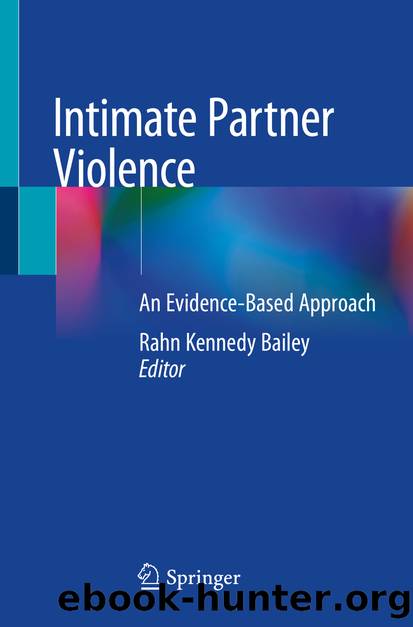Intimate Partner Violence by Unknown

Author:Unknown
Language: eng
Format: epub
ISBN: 9783030558642
Publisher: Springer International Publishing
Rahn Kennedy Bailey
Email: [email protected]
Keywords
Financial freedomIntimate partner violenceEconomic empowermentEqual payGender roles
In modern times, more women are in the workforce and contribute significantly to the household income. Does their financial independence have any influence on intimate partner violence (IPV)? In this chapter, we will explore if a womanâs financial independence is protective. Indeed, it stands to reason, that one of the elements of coercive control employed by abusive partners (financial control), is eliminated. With separation, a victim of IPV who is financially independent would likely be able to support themselves and acquire housing, transportation, and other necessities. If a woman is more financially successful than her male partner, is he less likely to perpetrate abuse? Is the male partner cognizant of all her options and is she granted leverage over him? Perhaps a male partner may feel as though he doesnât have control or financial leverage and may resort to violence to gain âcontrolâ in a relationship.
Is there a relationship between IPV and money? Certainly financial dependence may restrict a victimâs ability to leave an abusive relationship. Conversely, an abuser is often empowered by a victimâs financial dependence. The autonomy of a victim is restricted when their abuser controls money within the relationship [1]. Financial instability has been thought to be the greatest reason why an abused woman returns to her abuser [1]. Thus, it becomes exceedingly important to understand that financial dependence is a tether that keeps a victim inexorably tied to their abuser. Law enforcement, family, and friends may indeed be successful in separating a victim from their abuser. However, if care is not taken to address the victimâs needs of food, housing, healthcare, childcare, and transportation, an abuser may still maintain the power to control and potentially abuse [1]. Sadly, this factor may lead a victim to accept reconciliation with her former abuser.
In 1900, the wage of a working married woman was less than that of a working child. And so it was young unmarried women and girls who were more likely to work during this time. Moreover, their earnings went to their parents [1].
However, black married women did work during this time (the 1900s). Their wages were low (equivalent to white children). This did not grant them financial equality in the home. Often there could be resentment from their husbands [1].
As women gained more education in the 1900s, they were directed into âfeminineâ jobs (nursing, librarian, and teacher). Even in the early 1900s, women had no claim to the wages they made. If married, her husband could claim her wages. In the 1940s college was becoming accessible â usually for middle-class and above women. Womenâs presence in the workforce was more prevalent after the 1950s with more women continuing to work after marriage. Only 18% of working women earned more than their working husbands in 1987 [1].
Socially, societyâs perspective is still âa woman should or will find a man to support her,â and this may allow women to settle into situations where they are more likely to be financially dependent and so more easily coerced [1].
Download
This site does not store any files on its server. We only index and link to content provided by other sites. Please contact the content providers to delete copyright contents if any and email us, we'll remove relevant links or contents immediately.
Never by Ken Follett(2878)
The Man Who Died Twice by Richard Osman(2297)
Machine Learning at Scale with H2O by Gregory Keys | David Whiting(2283)
Will by Will Smith(2040)
The Stranger in the Lifeboat by Mitch Albom(1531)
Principles for Dealing With the Changing World Order: Why Nations Succeed and Fail by Ray Dalio(1373)
Friends, Lovers, and the Big Terrible Thing by Matthew Perry(1326)
New Morning Mercies: A Daily Gospel Devotional by Paul David Tripp(1320)
A Short History of War by Jeremy Black(1299)
HBR's 10 Must Reads 2022 by Harvard Business Review(1253)
The Strength In Our Scars by Bianca Sparacino(1240)
Go Tell the Bees That I Am Gone by Diana Gabaldon(1233)
Can't Hurt Me: Master Your Mind and Defy the Odds - Clean Edition by David Goggins(1226)
515945210 by Unknown(1206)
Love on the Brain by Ali Hazelwood(1095)
This Family Does It by Kevin Sellers(1080)
443319537 by Unknown(1071)
How to Live by Derek Sivers(1061)
Works by Richard Wright(1018)
